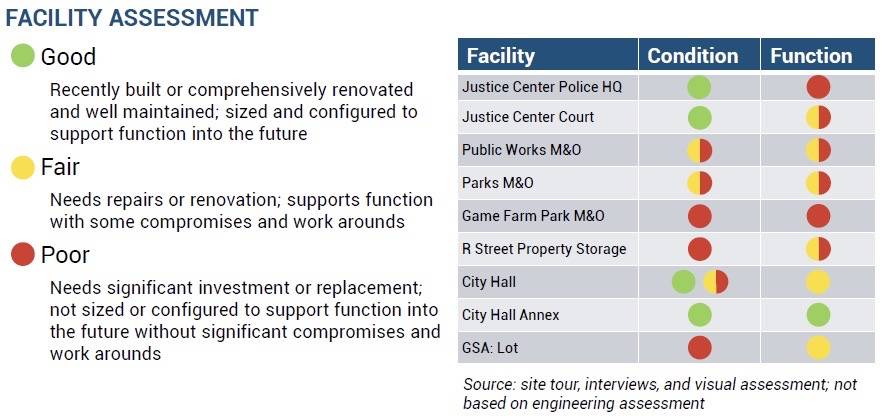While yard and storage functions at Auburn public works and parks maintenance and operations centers could be reviewed for operational efficiencies, both facilities are already far below the needed square footage for current service needs.
And the shortcomings would only worsen as services expand to meet the city’s growing needs.
So says a study the city commissioned last year to tell it whether existing city-owned buildings are meeting today’s needs,,and if so, would they continue to do so as the city’s population and associated city resources increase.
Monday night, Julie Basshuk and Beth Batchelder of consultant Seattle-based Maker’s Architecture and Urban Design joined Matt Larson, a senior project engineer for the city of Auburn, to present the council with the study’s findings, which are part of a larger facility master plan project now in the works.
Bassuk said looking at the city’s present needs and considering what the needs will be in 2040 presents, “a challenging bunch of issues.”
“We have a number of significant facilities that are ready for investment,” Bassuk told the council, “so they’re hitting that mid- or end-of-life cycle. They might have systems’ issues. And this is coming at you at a time where you are having budget challenges.
“Plus, how do you come up with an objective way to prioritize what you are going to spend money on?” Bassuk continued.
Deputy Mayor Claude DaCorsi asked the question on everyone’s mind: where will the city come up with the money to do what it needs to do in the years ahead?
“It really becomes … where are we going to be dollar wise, and how do we get there,” saidDaCorsi. “It would be wonderful if we had a blank check and could create a one-shop campus somewhere in the city with all the services and facilities in one spot, but that would be highly unlikely.”
The master plan process began in July 2019 with a focus on maintenance and operations facilities for public works, parks and Justice Center, which houses the Auburn Police Department and King County District Court – areas where an existing need can already be seen. The needs assessment included interviews with staff regarding facility issues and challenges, industry-best practices and the anticipated impacts of the city’s projected growth. Site tours were also conducted to assess the condition and function of the facilities.
Using a projected 20 percent growth rate based on similar growth estimates from the city’s comprehensive plan, the study found that some facilities would be operating with as much as a 67 percent deficiency of space by 2023, and that the public works facility, in particular, was already facing a 60 percent shortfall in needed square footage.
The study also found that inadequacies in space and layout at the Justice Center left the facility unable to support staff, an issue that will only become more critical as the city’s population continues to grow. In addition to desk and office space for patrol officers, command staff, investigators and the records team, the building is home to an armory, evidence storage, locker rooms and courtrooms that process more than 100,000 cases annually.
“This assessment provides an important opportunity for us to make informed decisions about what resources we are putting toward these facilities now and how we can plan accordingly to ensure that we fully anticipate how growth needs will impact funding priorities,” Gaub said.
The next phase of the plan will include a look at possible alternatives for development at existing sites and cost estimations for potential facility moves.
“I really like the direction you are going with this, especially when you are looking at the opportunities of perhaps aquiring land, selling off assets and looking at those combinations of things that can get us where we need to be,” said DaCorsi.
Some city buildings, DaCorsi noted, are already “there,” so the next question is how does the city take the next steps it must take, for instance, given a police facility that is “not only busting at the seams but where the seams have already broken loose.”
A follow-up presentation with findings from an alternative site assessment is scheduled for the council in May.
“This assessment is intended to identify proactive steps to address growth and support Auburn’s future generations,” said Director of Public Works Ingrid Gaub. “We know that our service needs for residents will increase in the coming decades. Completing a plan of this nature allows the city to be judicious with its investments in order to meet those needs in the most economical way by both increasing efficiency and reducing overall maintenance burdens and costs.”


